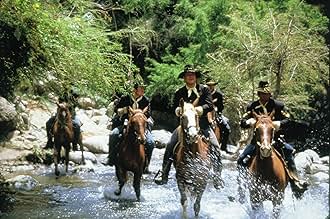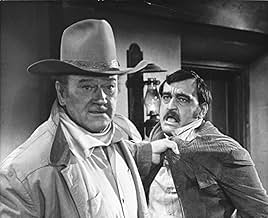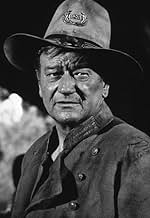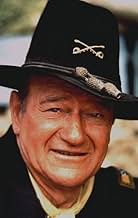CALIFICACIÓN DE IMDb
6.7/10
15 k
TU CALIFICACIÓN
Tras la Guerra Civil, Cord McNally busca al traidor que causó la derrota de su unidad y la muerte de su mejor amigo.Tras la Guerra Civil, Cord McNally busca al traidor que causó la derrota de su unidad y la muerte de su mejor amigo.Tras la Guerra Civil, Cord McNally busca al traidor que causó la derrota de su unidad y la muerte de su mejor amigo.
- Dirección
- Guionistas
- Elenco
Opiniones destacadas
Released in 1970, Howard Hawks' "Rio Lobo" starts with a thrilling Confederate train robbery of a Union gold shipment. After the war, Col. McNally (John Wayne) befriends Confederate Capt. "Frenchie" (Jorge Rivero) and his sergeant (Christopher Mitchum) to try to track down the Union traitors indirectly responsible for the gold robberies and the death of his close comrade and spiritual son. The trail leads to the West Texas town Rio Lobo and a showdown.
POSITIVES:
The opening credits features an exceptional two-guitar piece by Jerry Goldsmith with the camera zeroed-in closely on an acoustic guitar and the guitarist's hands. Sometimes I put the movie on just to see this part. The following half hour involves an excellent Confederate train robbery followed by the ensuing conflicts, which really make the film stand out from other Westerns. It's a great sequence, convincing and original. Civil War devotees should seek out "Rio Lobo" just for this.
Three notable women are featured: Jennifer O'Neill, Susana Dosamantes and Sherry Lansing, the latter of whom went on to became president of 20th Century-Fox and, later, chairman of Paramount Pictures (she's the scarred girl Wayne more or less rides off into the sunset with). I've heard jokes/comments over the years about the number of babes in the town of Rio Lobo, most single. But, really, there's only two in the town: Maria (Susan), who is seeing Frenchie's comrade (Mitchum), and Lansing, who isn't all that exceptional anyway; O'Neill was just passing through as part of some snake oil show.
The protagonists have good chemistry and camaraderie. The film was made right after the advent of the Spaghetti Western, which was known for amorality and lack of character depth. The protagonists in Italo Westerns were almost always antiheroes rather than heroes and caricatures rather than characters. They were grim, silent, one-dimensional killing machines, usually with dubious motivations (greed, revenge, lust) and just all-around comic-booky. While these types of characters are great when you're 13-20, they don't cut it when you're an adult and require more depth and realism. Don't get me wrong, the Spaghetti Westerns added (or perfected) a cool new style and grim sense of realism to the Western, but they accomplished this at the expense of morality, character depth and social realism. This explains why Clint Eastwood combined elements of both to forge the exceptional "The Outlaw Josey Wales" in 1976 after the decline of the Italo Western. Needless to say, it's nice to have a group of likable characters in "Rio Lobo" that get along and for whom you can root.
An exceptional example of this good-natured camaraderie is shown in the middle of the film before the protagonists reach Rio Lobo. McNally, Frenchie and Shasta are camping out in the desert where a running joke starts concerning McNally being "comfortable" for women (but not romantically attractive). I love this sequence.
There are great Arizona locations (along with Cuernavaca, Morelos, Mexico). In the Civil War sequences they did a pretty good job of pretending it was the East. Speaking of which, I like how the movie covers a lot of ground and isn't one-dimensional in setting. Critics complain that this makes the story disjointed when it's actually a positive thing.
NEGATIVES or SUPPOSED NEGATIVES:
The second half's plot concerning the political corruption in Rio Lobo is convoluted and my mind tends to wander at various points. So the story is compelling in the first half, but not so much in the second. Thankfully, the quality characters and the setting keep me watching.
Some have complained about the acting, particularly O'Neill, Rivero and Mitchum, but is this their fault or the writer's? I just chalk it up to the distinctiveness of the actors. I've met numerous unique people in life who act peculiarly, but it's really just their special individuality or style. Gary Cooper & John Wayne are good examples. I think that's the case here more than anything.
A couple scenes are unconvincing. For instance, when Frenchie suddenly darts into a house where Lansing's character is dressing, which is their first meeting; the ensuing conversation just doesn't smack of reality. I suppose the filmmakers were shooting for something romantically amusing, but it seems patched in from another movie. Another example is the episode where the protagonists raid the ranch house at night: People are lurking just around the corner and they aren't able to hear the nearby ruckus? Why sure!
The opening score is only heard a few more times, briefly, but not with guitars like the opening. This composition is too great to be heard in such a limited capacity. Why not at least utilize it for the ending?
"Rio Lobo" has slight similarities to Hawks & Wayne's "Rio Bravo" (1959) and "El Dorado" (1967), but "Rio Lobo" is far from a remake, as some suggest. It has an altogether different story.
BOTTOM LINE: Yes, the story is disjointed and there are a couple unconvincing scenes, but "Rio Lobo" possesses several aspects that are really good and even great, like the opening score/guitar sequence, the thrilling train robbery & Civil War parts, the likable protagonists & their camaraderie, the beautiful women and great locations.
The film runs 114 minutes.
GRADE: B-
POSITIVES:
The opening credits features an exceptional two-guitar piece by Jerry Goldsmith with the camera zeroed-in closely on an acoustic guitar and the guitarist's hands. Sometimes I put the movie on just to see this part. The following half hour involves an excellent Confederate train robbery followed by the ensuing conflicts, which really make the film stand out from other Westerns. It's a great sequence, convincing and original. Civil War devotees should seek out "Rio Lobo" just for this.
Three notable women are featured: Jennifer O'Neill, Susana Dosamantes and Sherry Lansing, the latter of whom went on to became president of 20th Century-Fox and, later, chairman of Paramount Pictures (she's the scarred girl Wayne more or less rides off into the sunset with). I've heard jokes/comments over the years about the number of babes in the town of Rio Lobo, most single. But, really, there's only two in the town: Maria (Susan), who is seeing Frenchie's comrade (Mitchum), and Lansing, who isn't all that exceptional anyway; O'Neill was just passing through as part of some snake oil show.
The protagonists have good chemistry and camaraderie. The film was made right after the advent of the Spaghetti Western, which was known for amorality and lack of character depth. The protagonists in Italo Westerns were almost always antiheroes rather than heroes and caricatures rather than characters. They were grim, silent, one-dimensional killing machines, usually with dubious motivations (greed, revenge, lust) and just all-around comic-booky. While these types of characters are great when you're 13-20, they don't cut it when you're an adult and require more depth and realism. Don't get me wrong, the Spaghetti Westerns added (or perfected) a cool new style and grim sense of realism to the Western, but they accomplished this at the expense of morality, character depth and social realism. This explains why Clint Eastwood combined elements of both to forge the exceptional "The Outlaw Josey Wales" in 1976 after the decline of the Italo Western. Needless to say, it's nice to have a group of likable characters in "Rio Lobo" that get along and for whom you can root.
An exceptional example of this good-natured camaraderie is shown in the middle of the film before the protagonists reach Rio Lobo. McNally, Frenchie and Shasta are camping out in the desert where a running joke starts concerning McNally being "comfortable" for women (but not romantically attractive). I love this sequence.
There are great Arizona locations (along with Cuernavaca, Morelos, Mexico). In the Civil War sequences they did a pretty good job of pretending it was the East. Speaking of which, I like how the movie covers a lot of ground and isn't one-dimensional in setting. Critics complain that this makes the story disjointed when it's actually a positive thing.
NEGATIVES or SUPPOSED NEGATIVES:
The second half's plot concerning the political corruption in Rio Lobo is convoluted and my mind tends to wander at various points. So the story is compelling in the first half, but not so much in the second. Thankfully, the quality characters and the setting keep me watching.
Some have complained about the acting, particularly O'Neill, Rivero and Mitchum, but is this their fault or the writer's? I just chalk it up to the distinctiveness of the actors. I've met numerous unique people in life who act peculiarly, but it's really just their special individuality or style. Gary Cooper & John Wayne are good examples. I think that's the case here more than anything.
A couple scenes are unconvincing. For instance, when Frenchie suddenly darts into a house where Lansing's character is dressing, which is their first meeting; the ensuing conversation just doesn't smack of reality. I suppose the filmmakers were shooting for something romantically amusing, but it seems patched in from another movie. Another example is the episode where the protagonists raid the ranch house at night: People are lurking just around the corner and they aren't able to hear the nearby ruckus? Why sure!
The opening score is only heard a few more times, briefly, but not with guitars like the opening. This composition is too great to be heard in such a limited capacity. Why not at least utilize it for the ending?
"Rio Lobo" has slight similarities to Hawks & Wayne's "Rio Bravo" (1959) and "El Dorado" (1967), but "Rio Lobo" is far from a remake, as some suggest. It has an altogether different story.
BOTTOM LINE: Yes, the story is disjointed and there are a couple unconvincing scenes, but "Rio Lobo" possesses several aspects that are really good and even great, like the opening score/guitar sequence, the thrilling train robbery & Civil War parts, the likable protagonists & their camaraderie, the beautiful women and great locations.
The film runs 114 minutes.
GRADE: B-
OK, put down the film criticism texts and just watch this fun movie for what it is. Feels like a TV movie, but several cuts above one. The opening train robbery sequence is pretty damn breathtaking for a "bad" movie. Bet some action directors have studied that one. "Lobo" is collection of a lot of good Hawks-ian moments recycled, sort of like a retrospective of his bag of tricks ie. "Yer necks broken," etc. The Duke aging, beat up, but still The Duke. Sherry Lansing pretty hot looking in her one role. Jack Elam the scene stealer. Too bad they didn't have the money to cast the other parts better--Mitchum or Martin would have helped a lot. Duke looks a little lonely. Plot sorta strung together, but Hawks was concentrating more on characters in his Bravo/Dorado/Lobo "trilogy." "Smart" dialog, while not up to 30s & 40s banter, still has clever moments by today's standards. Clever rifle bit at the end shows old timers' practical knowledge of things, like weapons. If you like old westerns, you'll like this one. Not among his greatest, but low end Hawks is better than no Hawks. I've seen much thinner stuff win awards.
This has to be unique in the history of Hollywood. Leading director and screen legend Howard Hawks loved this film so much that they made three variations of the same movie. By the time Rio Lobo was made, the theme was getting a bit thin, but it's still grand entertainment.
The first part of the film is set during the Civil War with John Wayne pursuing Confederates who are stealing army payrolls. He does catch up with them and the Civil War ends. He befriends his erstwhile enemies and asks for their help in locating the informer who was giving them information.
That all sets the scene for the third variant of Rio Bravo/El Dorado theme. Playing the old codger part is Jack Elam who by now had quit being a screen menace and was doing comedy and doing it well. The two younger sidekicks are the former Confederate enemies, Jorge Rivero and Chris Mitchum.
Rio Lobo had the presence of two stars of the Mexican cinema, Jorge Rivero and Susana Dosamantes. Dosamantes played Mitchum's girlfriend and Jennifer O'Neill played the Angie Dickinson part although Wayne was now deciding he was too old for the romance. She pairs off with Rivero.
In a small bit part is Sherry Lansing who left acting soon after Rio Lobo and really hit the big time, going into the production end of the movie business and becoming head of first 20th Century Fox and later CEO of Paramount.
The two principal villains are Victor French who played the neighbor on Little House On The Prarie and Mike Henry who was one of several screen Tarzans.
It's a good John Wayne western and that takes in a whole lot of territory pilgrim.
The first part of the film is set during the Civil War with John Wayne pursuing Confederates who are stealing army payrolls. He does catch up with them and the Civil War ends. He befriends his erstwhile enemies and asks for their help in locating the informer who was giving them information.
That all sets the scene for the third variant of Rio Bravo/El Dorado theme. Playing the old codger part is Jack Elam who by now had quit being a screen menace and was doing comedy and doing it well. The two younger sidekicks are the former Confederate enemies, Jorge Rivero and Chris Mitchum.
Rio Lobo had the presence of two stars of the Mexican cinema, Jorge Rivero and Susana Dosamantes. Dosamantes played Mitchum's girlfriend and Jennifer O'Neill played the Angie Dickinson part although Wayne was now deciding he was too old for the romance. She pairs off with Rivero.
In a small bit part is Sherry Lansing who left acting soon after Rio Lobo and really hit the big time, going into the production end of the movie business and becoming head of first 20th Century Fox and later CEO of Paramount.
The two principal villains are Victor French who played the neighbor on Little House On The Prarie and Mike Henry who was one of several screen Tarzans.
It's a good John Wayne western and that takes in a whole lot of territory pilgrim.
Being the John Wayne/Howard Hawks fan that I am, I expected great things from "Rio Lobo." Unfortunately, it's one of the Duke's weakest efforts. Howard Hawks has a style all of his own, but none of it is in evidence here. As a matter of fact, the one thing this picture reminds me of is those cheesy A.C. Lyles westerns from the '60s, which were made cheap and loaded with familiar faces like Rory Calhoun, Howard Keel, Rod Cameron, etc.
The biggest problem in this film is the performances of the younger cast members. Jennifer O'Neill is ravishingly beautiful but can't act her way out of a paper bag. Her scenes with Rivero are among the most embarrassing on record. Rivero has trouble with English and seems to be reciting his lines phonetically; O'Neill doesn't seem to have the slightest idea of what she is doing. She steps on other actors' lines, forgets hers, misses cues, and is a pretty good argument for models not being paid for opening their mouths. Future studio head Sherry Lansing has a small part as a Mexican girl who ges beaten up by bad sheriff Mike Henry; she was a much better studio head than an actress. It's up to the old pros like Wayne, Bill Williams, Jim Davis, Victor French and especially David Huddlestson as a frontier dentist to give this picture some semblance of professionalism, performance-wise. Jack Elam as an ornery old codger gives an over-the-top performance that is nevertheless fun to watch. Mike Henry is quite good as a sadistic, crooked sheriff. Yakima Canutt staged the rousing action scenes with his usual flair, and there's a good Jerry Goldsmith score. Unfortunately, however, the trite script and the incompetent performances are obstacles that neither Hawks nor Wayne can overcome. O'Neill has a line early in the film that pretty much sums up her performance: "I'm acting like an idiot, aren't I?"
Yup.
The biggest problem in this film is the performances of the younger cast members. Jennifer O'Neill is ravishingly beautiful but can't act her way out of a paper bag. Her scenes with Rivero are among the most embarrassing on record. Rivero has trouble with English and seems to be reciting his lines phonetically; O'Neill doesn't seem to have the slightest idea of what she is doing. She steps on other actors' lines, forgets hers, misses cues, and is a pretty good argument for models not being paid for opening their mouths. Future studio head Sherry Lansing has a small part as a Mexican girl who ges beaten up by bad sheriff Mike Henry; she was a much better studio head than an actress. It's up to the old pros like Wayne, Bill Williams, Jim Davis, Victor French and especially David Huddlestson as a frontier dentist to give this picture some semblance of professionalism, performance-wise. Jack Elam as an ornery old codger gives an over-the-top performance that is nevertheless fun to watch. Mike Henry is quite good as a sadistic, crooked sheriff. Yakima Canutt staged the rousing action scenes with his usual flair, and there's a good Jerry Goldsmith score. Unfortunately, however, the trite script and the incompetent performances are obstacles that neither Hawks nor Wayne can overcome. O'Neill has a line early in the film that pretty much sums up her performance: "I'm acting like an idiot, aren't I?"
Yup.
After an excellent start with the train ambush, the movie loses steam and never really picks up, an unhappy way for a great director like Hawks to bow out. But I did not get too bored and was happy enough to stick it out to the end, even though the writing is too flat and derivative with echos of half a dozen better movies. Rivero lacks the charisma that could have helped to save things but I do not think O'Neill is as bad as some reviewers claim – not expressive enough with her dialogue at this stage but I think you can see the spark that gave her a respectable career in movies. But, as usual, Wayne saves the day. Even in a disappointing movie like this, that enormous screen presence reminds you just what a great star he was.
¿Sabías que…?
- TriviaRobert Mitchum visited his son Christopher Mitchum during filming. Director Howard Hawks asked the elder Mitchum to reprise his El Dorado (1966) role as a drunken sheriff, but Mitchum claimed he was now retired. John Wayne responded, "Mitch has been retiring ever since the first day I met him."
- ErroresWhen uncoupling the train from the locomotive the rebels pull up on a lever opening the knuckle coupler and releasing the car. At the time of the Civil War railroads used a link and pin coupling system. The knuckle coupler was invented by Eli Janney in 1873, eight years after the civil war ended. They are still in use today.
- Citas
Cord McNally: Do you think you could sneak up on the fella at the gate?
Phillips: I could sneak up on a *coyote* if I've a mind to!
Cord McNally: Did you get that fella at the gate?
Phillips: He's at *another* gate now, lookin' fer *Saint Peter*!
- ConexionesFeatured in Plimpton! Shoot-Out at Rio Lobo (1970)
Selecciones populares
Inicia sesión para calificar y agrega a la lista de videos para obtener recomendaciones personalizadas
- How long is Rio Lobo?Con tecnología de Alexa
Detalles
- Fecha de lanzamiento
- Países de origen
- Idiomas
- También se conoce como
- Rio Lobo
- Locaciones de filmación
- Productoras
- Ver más créditos de la compañía en IMDbPro
Taquilla
- Presupuesto
- USD 4,000,000 (estimado)
Contribuir a esta página
Sugiere una edición o agrega el contenido que falta

Principales brechas de datos
By what name was Río Lobo (1970) officially released in India in English?
Responda





































